Timing. There’s not much to growing onions successfully in Southern California beyond timing.
If you sow the seed or plant the plant at the right time, you’re almost guaranteed a nice bulb to eat. So many times I’ve heard people say their onions didn’t grow well, and when I inquired further I always found out that it was a matter of bad timing.
It’s not your fault. It’s the seed packet’s fault:
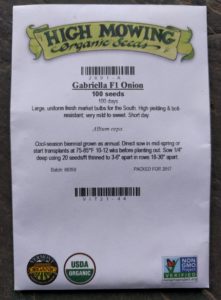
As a general rule, disregard the directions about timing on seed packets. They’re usually written for gardeners in the Midwest, the Pacific Northwest, the South, New England, anywhere but Southern California.
We’re different. Here, fall is ideal onion-sowing time in Southern California. Think October through December.
Checking my notes from past years, I see that I got decent onion crops from sowing as early as mid-September, and as late as Christmas. But my best onion crops were sown between mid-October and the end of November. These sowings I transplant into the garden ground 4-6 weeks afterward.
If you’re buying seedlings at a nursery, I would buy and plant in November or December for best results.
The latest I’ve ever planted an onion crop that gave acceptable results was January. The problem with planting in January or later is that the bulbs usually don’t get as big.
How onions grow
Why is it that these dates work well? What happens is that onions start growing during the mild fall weather and look like blades of grass.
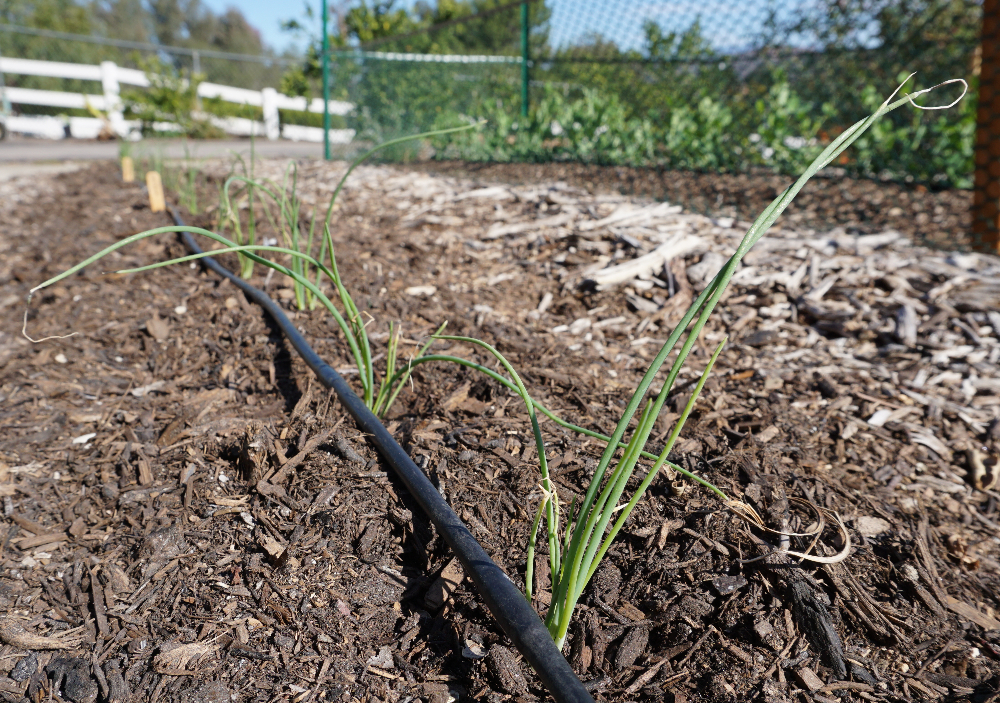
Through winter they expand to reveal the tubular shape of their leaves.
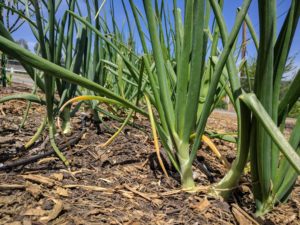
Come spring, just above the dirt, the bulbs form. The bulbs are actually a bunch of fattened onion leaves that are — instead of green — a white or red or yellow color.
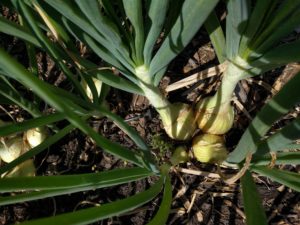
Onions are photoperiodic, which means that they respond to how long the days are. In the spring, the days are longer and the onions respond to that by forming bulbs.
Once bulbs are full size, the green tops start dying; they become yellow and often kink and topple over.
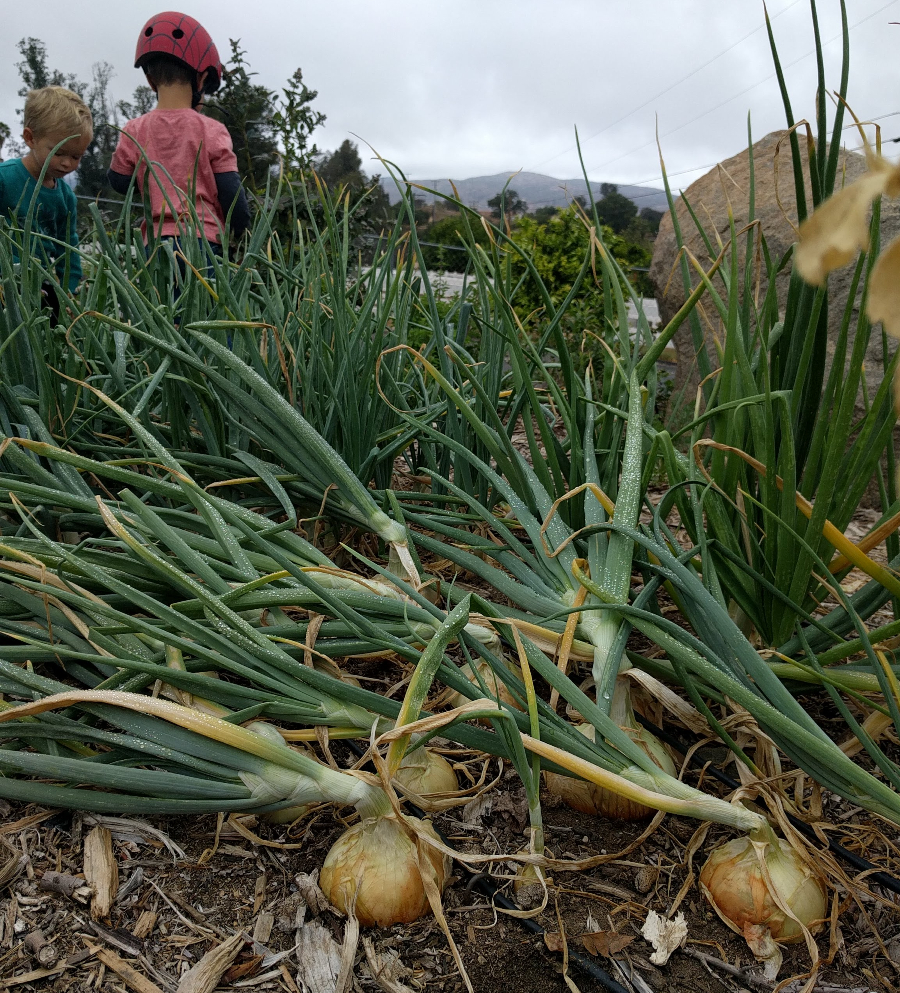
Time for harvest. Here is my harvest of ‘Madalyn’ yellow onions in May of 2021.
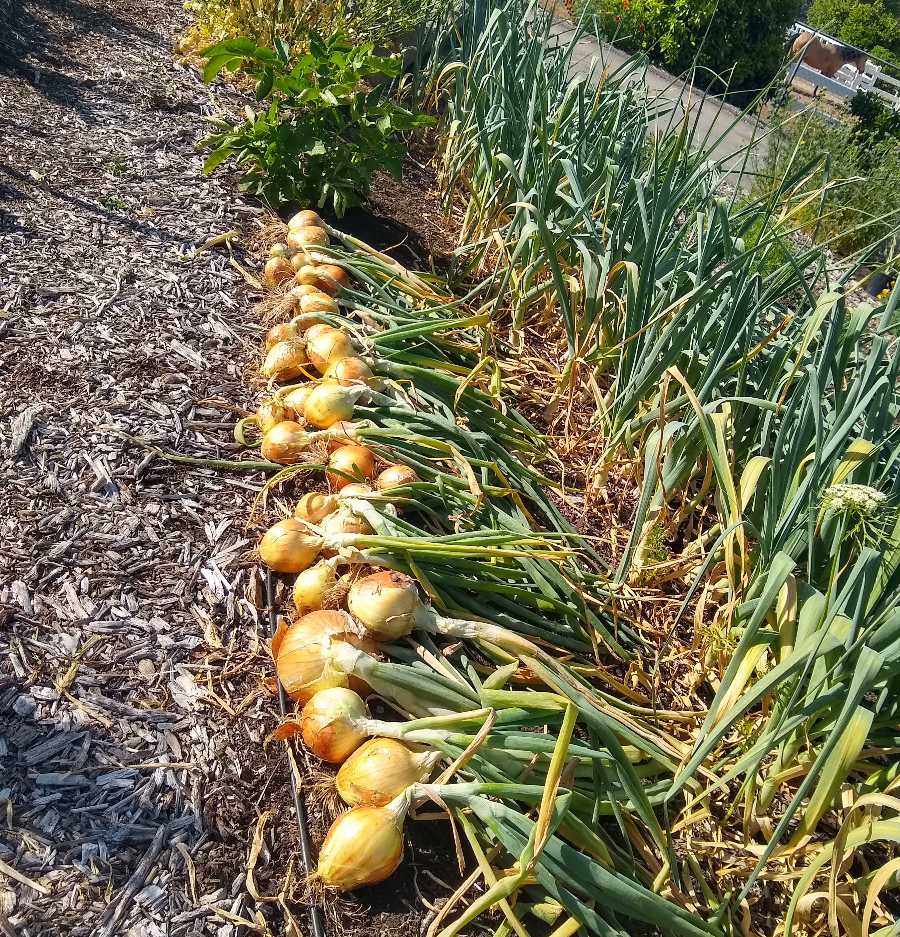
That’s how the life of an onion plant is supposed to proceed. If, however, you sow onions at the wrong time — in the spring as seed packets often suggest, for example — then the plants will grow just fine, yes, but they won’t make the big bulbs you’re hoping for.
Varieties
I’ve tried a lot of varieties over the years. Some of the best performers in my Southern California gardens have been ‘Yellow Granex’ (seeds from Botanical Interests), ‘Gabriella’ (seeds from Johnny’s), ‘Madalyn’ (seeds from Johnny’s), ‘White Castle’ (seeds from Johnny’s), and ‘Red Rock’ (seeds from Johnny’s).
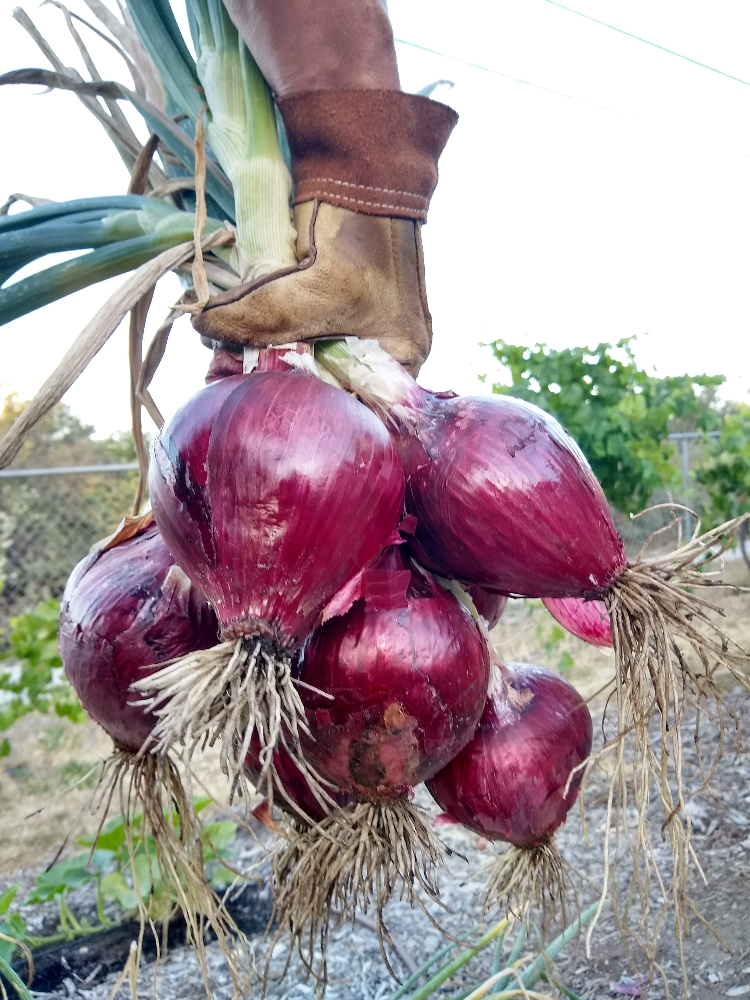
I usually grow my onions from seed these days because the varieties available are more numerous and often higher quality than what is available at the local nursery, and also I can be in better control of my planting dates when I sow my own. Yet I’ve also had lots of success when I’ve bought onion seedlings at a nursery so that’s a perfectly viable option too.
Can we grow “long-day” onion varieties in Southern California? You may have heard that we can’t. Onion varieties are categorized as short, intermediate, or long day — referring to the daylength at which they will respond and form bulbs.
The higher your garden’s latitude, the longer the daylength is in spring. The story goes that if you’re gardening in the southern part of the U.S. you can only grow short-day varieties whereas if you’re up north you grow varieties categorized as intermediate or long day.
But I haven’t found this to be true. I’ve grown long-day onion varieties such as ‘Walla Walla’ and ‘Ringmaster’ with good results. And I know others who have too. (A few years ago, I wrote this post about it: “You sure can grow long-day onions in Southern California.”)
Spacing
Onions can grow surprisingly close to one another. Just picture how big you want the bulbs to get and then space the plants accordingly.
Rather than evenly spaced rows, for the last few years I’ve been keen on planting onions in groups. I prefer groups of three. Groups of only two waste space while groups of four end up being so crowded that some bulbs don’t have enough space to fully expand. Groups of three are optimal.

If you buy seedlings at the nursery, you’ll find them in clumps of dozens within each six-pack cell. You must gently separate them into singles or small groups at planting time.
For me, I just sow four or five seeds in each cell and then remove the weakest one or two at planting time, if necessary, so that I get my group of three.

One reason I like this grouping arrangment is that it works well with drip irrigation. You can just plant each group near a drip emitter.
Harvesting
I stop watering my onions a few weeks before I harvest them. Usually this means cutting off the water in mid or late April (later for some varieties though). There is still enough residual moisture in the soil for the plants to finish their growth, and allowing the surface of the soil to dry out makes it less likely to get any rot starting near the base of the bulbs.
To harvest, I scratch dirt away from the base of the bulb and then twist it in order to break the roots. For group plantings, I use a trowel or knife to cut the roots near the base of the bulbs.
It is often recommended to leave the harvested onions on the ground to dry for a few days, but I no longer do this. It takes up garden space, and it sometimes ends up in sunscalded bulbs. I get better results from laying the bulbs out in the shade elsewhere, like on the back porch or in the garage.
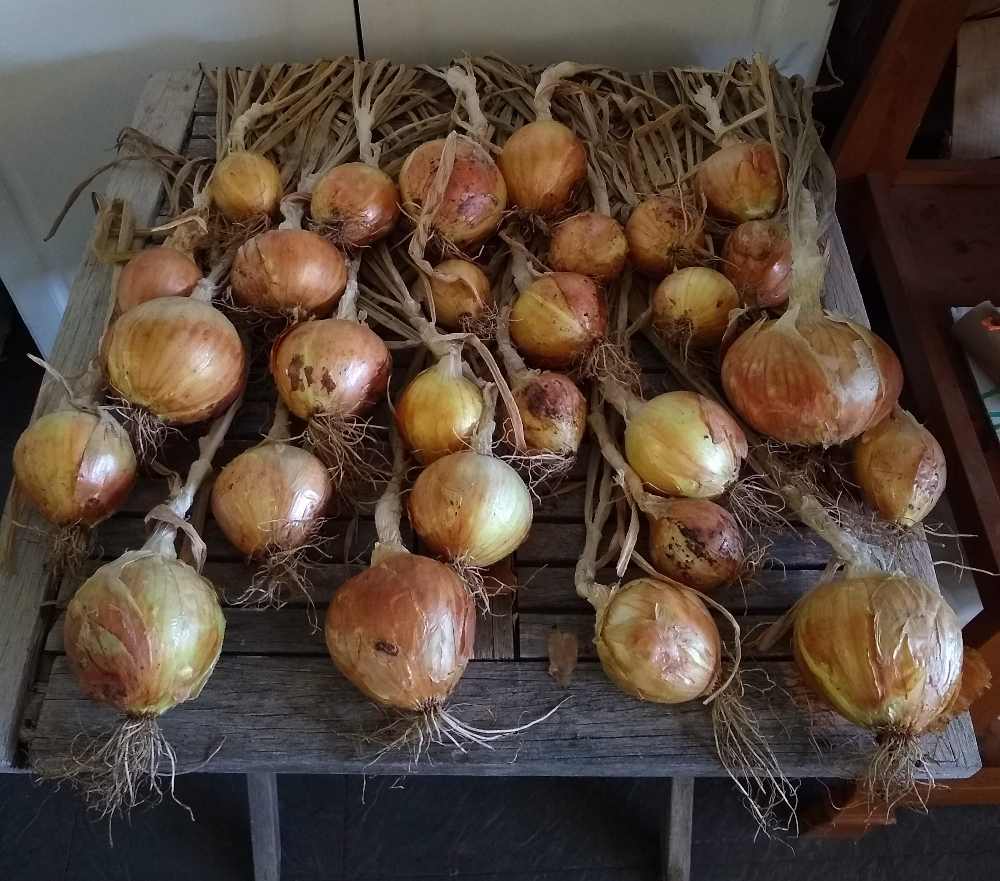
Just don’t stack them on top of each other for long or else they won’t dry properly and they’ll get rotten spots. Laying them out in a single layer is best.
The goal is to let the tops totally dry, the roots totally dry, and the outer layers of skin over the bulb totally dry. This way you’ll have a seal around your healthy onion bulb, and it will store for as long as possible.
Storing
If you’ve grown just a handful of onions, then you should start eating them as soon as you harvest them. If you’ve grown dozens of bulbs, however, you’ll want to grade them. The lowest grade is given to plants that have made flowers.
Onion plants that flower will have a bulb with a hollow core. The bulbs are still perfectly edible, but they won’t store well so you should eat those bulbs first.
Why do some onion plants make a flower stalk? Contributing factors seem to be variety, planting date, and cold weather at certain times during plant growth. For more on this, see my post, “Why do onions flower?”
Bulbs that feel solid on all sides will store the longest. How to store them?
It depends on your space constraints. If you have room in a refrigerator, then that is the best vessel for storing onions. As I write this here in late October, we are almost finished eating our onions that were harvested in May and June and were stored in the fridge. They kept perfectly in the fridge for over four months.
Without space in the fridge, find another spot that is nearest in environment to a fridge: shaded and cool (though not below 32 degrees). For me, this means hanging in the garage:
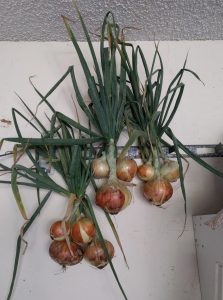
Oh yeah, what about pests and diseases? Haven’t seen them on onions, personally, which is way I say that growing onions in Southern California is mostly about timing.
All of my Yard Posts are HERE
Thanks for your support.

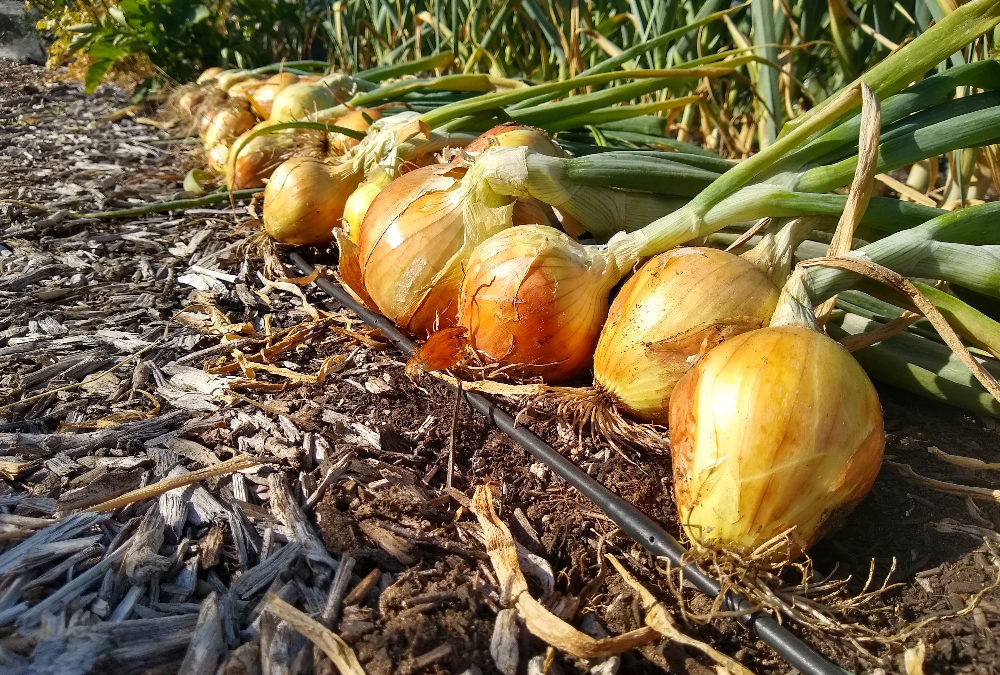


Super helpful!! Thanks!
I live in Ohio and all I do when I see the first little tiny bit of a bud come up for the flowers for the onions is to pinch it off. I’ve still gotten beautiful onions that are very large with doing that. This year I have onions that have held over and I’m going to put them back in the ground after I’ve cleaned them off and I want them to go to Seed because I’d like to see if I can plant by Seed instead of Onion starts this coming year 2025
Awesome!! I will have great onions this year!! Thanks for all of your observations!
Great summary points Greg thank you very much for taking the time to summarize the growing and harvesting of onions.
We successfully grew seedling onions in containers this past year however I grew them 6 inches apart which produced very large red and white onions. this next season I’ll try the cluster approach which I think is a better way when growing in a container. thank you for that idea.
one thing you did not mention, and that’s why I’m writing, we noticed a remarkable difference between the taste of what we grew and the taste of what was available at the grocery store. Our onions were noticeably sweeter and truly provided a pure onion taste, with no unwanted after taste. our taste test came about by accident because we had forgotten about one barrel of onions both red and white and because we thought we were out of homegrown onions we bought onions at a grocery store.
We’ll soon be planting seedlings again.
PS Once our hillside Construction project is completed I’m still planning to send you pictures of our Hass-Carmen Avocado tree
Thanks for the comments, Jock. If you plant in clusters this year, just be aware that some of the onions won’t be perfectly spherical; some have a small flat spot on the side where they’re abutting another onion. I don’t care about that, but I imagine some people might.
Yeah, some people might think that onions are cheap and uniform, and so you might as well buy them at the grocery store. Not so. Good point.
Look forward to seeing the Hass-Carmen.
What a fantastic website. Great information! Have you ever noticed a higher percentage of onions plants flowering when you grow them from seedlings instead of from seeds?
Keep up the great work!
Thanks so much, Shawn. I can’t say I have a great answer to that question because I’ve never done a rigorous comparison. Last year, for example, the onions I grew from seed didn’t flower at all, not a single one. But the onions I grew from seedlings that I bought from the nursery flowered a bit. Problem is, they were all different varieties. On top of that, I planted the seedlings from the nursery about two weeks before I transplanted the seedlings that I grew from seed. Can’t make any real conclusions from all of that.
I suspect that if the varieties and the timing of planting are the same, there shouldn’t be much of a difference in bolting.
A University of California publication says that bolting is primarily driven by temperatures being cold when the onion plants are about two months old. (In other words, it’s up to the weather and out of your control.) But it also says that variety and timing of planting are factors. Seems like a phenomenon that is not perfectly understood. Here’s the link to that pub: http://anrcatalog.ucanr.edu/pdf/7242.pdf
Just curious if your onions this year are experiencing a higher then normal amount of bolting? This year my crop has been the worst ever. Seems to lend credence to the theory that changes in weather is a contributing factor. Thoughts?
Hi Shawn,
That’s really interesting. Mine haven’t shown any bolting yet. Zero. This is strange because I’ve always had at least a few in the past.
But this year I planted later than I ever have (planted seedlings on January 1 and 16). Maybe I unwittingly planted at a good time for the unusually warm then chilly winter we had whereas in a normal year I would’ve had a lot of bolting.
Then again there is still time for mine to bolt.
how can you tell when the seedlings are ready to transplant? thanks, great stuff!
Hi Judith,
Onion seedlings can be transplanted anytime, technically. You just have to be extra gentle with small seedlings because they’re more fragile. But I usually transplant mine once each plant has two or more leaf blades. At that point, they are at least as tall as one of your fingers.
So I transplanted my onions as you said (thanks for getting back to me!) and they are fine, but the tiny bulbs at the bottom are sitting just above the soil line. Another gardener said I have to keep the bulbs covered with soil. What should I do?
Hi Judith,
Onion bulbs don’t need to be covered by soil, unlike carrots or beets. The bulbs are just enlarged leaves actually.
Hi Greg,
I made the mistake of sowing some green onion seeds in socal in early April. They are a few inches tall now. Should I just rip them up and plant something else, or is it worth leaving as an experiment?
Hi Marc,
No, don’t rip out the green onions. They’ll grow fine. You can grow green onions all year. It’s just the bulb onions that need to be planted during a specific window of time in order to form large bulbs.
Thanks Greg!
Is this the same for scallions? They grow year round?
Hi Greg,
Thanks for your great tips in the article.
Couple of questions we have:
We have onion seeds and a packet of onion bulbs that we picked up at the local nursery. Should we plant the seeds in October and bulbs in December?
Should we sow the seeds directly in the ground like the bulbs or should we start the seeds indoors in trays?
Thanks
Hi Zee,
Your plan and your timing sound good. You can sow the seeds directly in the ground; however, if you are likely to have weeds also germinate around the onion seeds then I would choose to sow them indoors in trays. I once sowed onion seeds in the ground in a new bed and spent many annoying hours carefully weeding around the delicate onion seedlings.
They’re fussier to prepare than onions, but over many years I grew Ed’s Red shallots in Irvine, CA. Simply broke clumps of bulbs into single bulbs and planted every Halloween. No pests, no diseases, tolerant of irregular watering, free seed bulbs every year, simple to dry-cure the rest for long-term storage — so easy a caveman can do it and may have, depending on who Ed was. 🙂
Awesome, Randy! I’m going to look for some.
Oh wow! Perfect timing in that we’re muddling about trying to plant our cool season garden…and we hadn’t thought of bulb onions! Your discussion and example of how you successfully grow onions inspired and encouraged us to try onions now, after our spring planted onions came to nothing! Thank you! Great post!
Hi Greg: what size of emitters, how spaced and how much water to you apply?
Hi Thomas,
For the last few years I’ve used 0.5 gallon-per-hour emitters spaced every 9 inches. I water them like any other vegetable in that I approximately replace reference ET according to the plants’ size, but this ends up being very little water because the plants are small now and then the rains usually take care of much watering through late fall and winter until it’s about time to cut off watering and get ready for harvest. Over the past week, for example, I’ve been giving each young plant about a cup of water per day. (Not that I always water every day though since the weather is so variable this time of year.)
I planted onion starts in the spring and as you guessed, they grew but the bulbs are very small. Can I leave them in the garden and harvest in the spring or should I pull them up and start over?
Hi Andie,
If you’re interested in getting large bulbs, then you should start new onions now, which you’ll harvest in the spring.
Hi Greg,
When you harvest your onions and set them to dry, do you cut off the green leaves? If I compare to something like carrots, I seem to find that if I leave the leaves on after harvesting, the carrot root will become soft – like the leaves are drawing water from the carrot root.
Hi Griff,
I do not cut the leaves off the onions. If they’re harvested at the right time and set to dry in the right conditions, the leaves will dry and brown, as will the outer skin on the bulb, but the inside of the bulb remains fresh.
I don’t know if this is applicable to your carrot harvests, but I’ve found that the key to keeping the roots firm is keeping them cold. When I harvest, they go straight into cold water. And then I put them in a plastic bag in the fridge, and the plastic bag needs some water in it to prevent the roots from drying out. If I do that, I haven’t noticed a difference in quality whether I remove the tops or not. Doesn’t seem to matter.
I’m curious if you’re seeing a higher incidence of onions bolting this year? It’s definitely a much higher percentage in my garden this year. The only variable would seem to be our wet winter.
Hi Shawn,
Just the other day I noticed a couple bolting and I was bummed. But as of now it’s only a couple. I’ll have to wait and see if more and more bolt in the next few weeks. We should compare planting dates and varieties to see if we can find differences in the bolting.
I had maybe 30% of my Candy (intermediate day) sweet onions with a definite center this year. The hollow center ranged from 1″ to 1/8″. That’s why I am reading when to plant onion seeds. Previously I had grown transplants from Dixondale along with whatever I had started from seed.Didn’t have this hollow center (bolting) problem. I am 4 miles from the pacific at latitude 35N (near Pismo Beach).
Hey Greg, thank you for the helpful info! This is my second attempt growing onions, I’m in El Cajon, Ca. Hoping for a good harvest this year as the last time I tried onions they seemed to be taking forever to finish bulbing and I didn’t really get the results I am this year thanks to your tips. I have about 120 growing in bunches of 3 like you said, half red and half white. I’m thinking they will be finishing into a June harvest since I have no signs of soft necks yet, but I got a bunch of bulbs so I’m pretty amped. Cheers and thank you !
That’s rad, Joel. Looking promising. My yellow, short-day onions are nearing harvest now. A few of the tops have collapsed. They look pretty good; a few have flowered but not many. My whites and reds are still at least a month from harvest though. Hope you get good results!
Not an onion subject. A Santa Ana wind blew my Reed avocado and its post off right at the graft. Very disappointing, but I let the root stub grow, planning on grafting a Reed back on it. It grew wildly, and PTL, it has about 15 Reeds on it, somehow. I began making shade cloth covers hoping to foil the ground squirrels, but that’s too much work. So I ordered some extra large polyester socks and covered some, but most are too large for the stretch socks. I sure wish someone would start a little home business making shields that squirrels can’t penetrate. BTW, the ground squirrels have already eaten my whole crop of macadamia nuts. Thousands of nuts that never got to ripen.
Hi David,
You should try the squirrel shield over avocados in this post: https://gregalder.com/yardposts/fruit-tree-pest-management-ideas-worth-trying/
See if it works for you. I’ve never tried it, but I’m told it has worked for others.
My grandparents have a huge old macadamia tree and the squirrels have been getting fat and happy from it for decades. Either you have squirrels or you have macadamia nuts, but you can’t have both, right?
Thank you, I’ll try that paper plate shield on my Gwen. But these ground squirrels often nip the stem to drop the avocado. I find a lot of them partially eaten with a bit of stem still attached. Just last eve It came to me to try making aluminum window screen sleeves that cover from the bottom up to over the stem and lap over the feeder limb to be pinned there. Screen would be a lot easier to work with than the shade cloth. I’d love to have cats, but the coyotes in Yorba Linda are killing outdoor cats. We have an online “Neighborhood” here and almost every night, at least another cat is reported eaten.
Hi Greg, Have you tried or had any luck with Shallots? They are my favorite allium and I’ll be trying some this year. Wondered if you had any thoughts to short-circuit the mistakes I will most likely make. Cheers!
I’ve enjoyed growing (edibles) in the garden most of my life, and now that I’ve retired for the (third time), I enjoy watching this grow more than ever. (I don’t enjoy my water bills…)
I buy seeds to start them in small cartons or cups, on the patio, to keep the birds from digging up the seeds, even before they germinate.
I’ve had problems with (seed) packages not being what is printed on the packaging. It’s not just one company and it doesn’t matter whether I’ve purchased seeds from Lowes, garden centers, or even The Dollar Tree. I’ve planted seeds that were (supposed to be green zuchinni and they sprouted and grew as yellow squash. I can live with that, but I’ve planted rows and rows of cucumbers that never flowered, nor produced one single cucumber. I think I should just harvest the seeds (non-gmo plants), from previous season’s fruit and hope they aren’t sterile plants.
The prices on seed packages are getting worse, each season. I’ve purchased $4.95 packages of seeds and there may only be 12 seeds inside. Burpee and company, should be ashamed. We might as well just buy a single (matured) plant for $3.95 and be happy.
I sure enjoy receiving your weekly updates and thoughts on Avocado growing.
Thanks Greg.